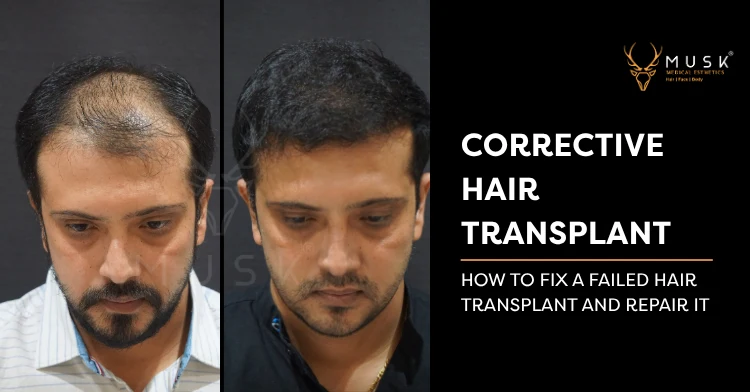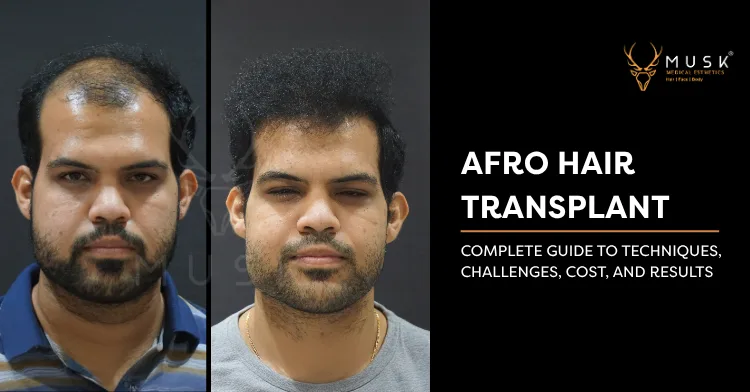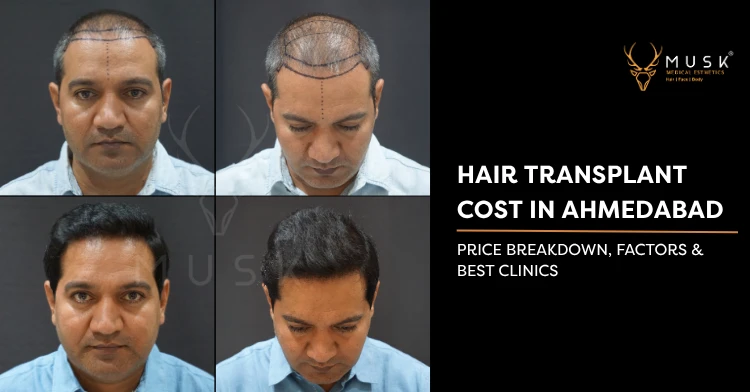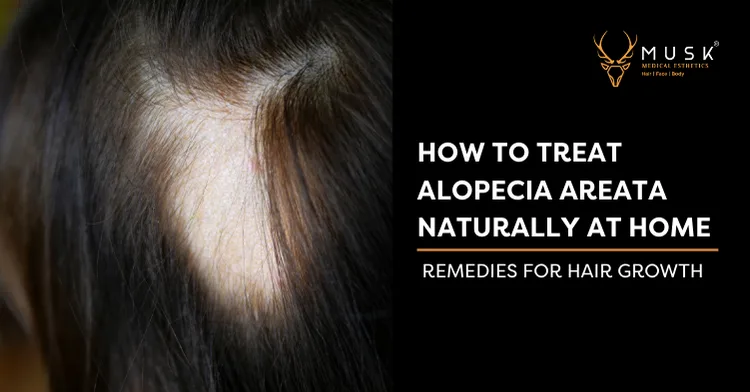Corrective Hair Transplant: How to Fix a Failed Hair Transplant and Repair It

A hair transplant is a significant investment of time, money, and hope. When the results don't meet expectations, the disappointment can be devastating. But a failed procedure is not the end of your journey. With advanced techniques and surgical artistry, it is possible to repair the damage and achieve the natural look you originally wanted.
At Musk Clinic, we understand the emotional weight of a poor surgical outcome. Led by the internationally trained Dr. Anand B. Shah, our team specializes in complex revision procedures. We combine deep expertise with India's most advanced robotic technology to turn disappointment into renewed confidence. This guide will walk you through everything you need to know about corrective hair transplants.
Can a Failed Hair Transplant Be Fixed?
Yes, in the vast majority of cases, a failed or botched hair transplant can be significantly improved or completely repaired. A corrective hair transplant is a highly specialized procedure designed to address the specific shortcomings of a previous surgery. It's not just about adding more hair; it's about strategic correction.
The primary goal of a repair procedure is to reverse the signs of a bad transplant. This can involve softening an unnatural hairline, camouflaging scars, increasing density, and correcting the angle of transplanted hairs. The success of the repair, however, depends entirely on the skill of the surgeon and the technology used.
What Are the Telltale Signs of a Bad Hair Transplant?
Recognizing the signs of a poor outcome is the first step toward seeking a solution. A successful transplant should be undetectable to the naked eye. If you notice any of the following issues, you may be a candidate for a corrective procedure.
- An Unnatural, "Pluggy" Hairline: This is the most common sign. Grafts placed in straight lines or unnatural clusters create a "doll's hair" look, which was common with outdated techniques.
- Poor Graft Placement: Hairs growing at the wrong angle or direction look chaotic and unnatural. A skilled surgeon mimics the natural flow and orientation of your original hair.
- Low Density and Poor Growth: If a large percentage of the transplanted grafts failed to grow, you'll be left with sparse, patchy results that don't provide adequate coverage. The success rate should be above 90%.
- Visible Scarring: While all surgery leaves scars, they shouldn't be highly noticeable. A large, stretched scar from a Follicular Unit Transplant (FUT) or numerous dot-like scars from a poorly performed FUT Follicular Unit Extraction (FUE) are signs of a bad procedure.
- Depleted or "Moth-Eaten" Donor Area: This occurs when a surgeon over-harvests follicles from the donor area at the back of the head. It leaves the area looking thin and makes future transplants very difficult.
- Pitting or Cobble stoning: The recipient area may have bumps, divots, or an uneven texture if grafts were placed too deep or too superficially into the scalp.
Why Do Hair Transplants Fail in the First Place?
Understanding the cause of the failure is crucial for planning a successful repair. A failed transplant is almost never the patient's fault. The responsibility typically lies with the initial clinic or surgeon for one or more of the following reasons.
The most significant factor is an inexperienced surgeon. Hair transplantation is as much an art as it is a science. A surgeon without a deep understanding of facial aesthetics and hair growth patterns can create a technically "correct" but visually unnatural result.
Outdated techniques are another major culprit. A clinic that hasn't invested in modern technology and training may still use methods that produce harsh, pluggy results. This is why choosing a clinic that pioneers new technology is so important.
The technical team's handling of the grafts is also critical. Hair follicles are delicate living tissues. If they are left out of the body for too long or are damaged during extraction and implantation, their survival rate plummets.
Finally, poor planning or a misdiagnosis can lead to failure. If the surgeon doesn't accurately assess your pattern of hair loss, stabilize it with medication if needed, or plan for future loss, the results won't last. A good surgeon creates a plan that looks natural both today and ten years from now.
How Does a Corrective Hair Transplant Work?
Repairing a failed transplant is a meticulous process that requires more skill and planning than a primary surgery. It is completely customized to the individual's specific problems. At Musk Clinic, the journey begins with a thorough and honest evaluation.
Step 1: The Expert Consultation
The first step is a detailed assessment with an experienced revision surgeon like Dr. Anand B. Shah. This involves analyzing the scalp, determining the extent of the damage, assessing the health of the remaining donor hair, and understanding your goals. We listen to your story and establish realistic expectations for the repair.
Step 2: Creating a Strategic Repair Plan
Based on the consultation, a customized surgical plan is created. This plan outlines exactly how each problem will be addressed. It’s a multi-faceted strategy that may combine several techniques to achieve the best possible aesthetic outcome.
Step 3: Advanced Surgical Repair Techniques
The actual surgery may involve one or more of the following advanced methods:
- Graft Excision & Re-implantation: Poorly placed, "pluggy" grafts are carefully removed. These follicles are then dissected under a microscope into smaller, natural units and re-implanted in the correct location, angle, and direction.
- Scar Camouflage: For patients with visible scarring in the donor or recipient area, we use the FUE technique to implant single-hair follicles directly into the scar tissue. This breaks up the scar's appearance and makes it blend seamlessly with the surrounding hair.
- Hairline Redesign: We use fine, single-hair grafts to create a soft, natural, and age-appropriate hairline in front of any old, pluggy grafts. This new "transition zone" effectively hides the old work and creates a dramatically more realistic look.
- Adding Density: The primary goal is often to increase fullness. A surgeon carefully places new grafts between the existing transplanted hairs to create a denser, more uniform appearance without damaging the old follicles.
- Body Hair Transplant (BHT): In severe cases where the scalp's donor area is depleted, hair follicles can be harvested from the beard or chest. This highly specialized technique, offered at Musk Clinic, provides a source of new grafts when all other options are exhausted.
Can Robotic Technology Help Fix a Bad Transplant?
Absolutely. In a corrective procedure, every single hair follicle is precious. This is where advanced technology provides a critical advantage. Musk Clinic is the first center in India to introduce the ARTAS 9X Robotic Hair Transplant system, and it is a game-changer for repair work.
When a donor area has been damaged or partially depleted by a previous surgery, the precision of the ARTAS robot is unparalleled. Its AI-powered algorithms and high-definition imaging system can intelligently identify and select the healthiest remaining follicles for harvesting.
This robotic precision accomplishes two crucial things:
- First, it ensures that only the best grafts are selected, maximizing their survival rate.
- Second, it minimizes any further trauma to the already compromised donor area, preserving it for any potential future needs. This level of accuracy is simply not achievable with manual techniques alone, making it an invaluable tool for complex repair cases.
This level of accuracy is simply not achievable with manual techniques alone, making it an invaluable tool for complex repair cases.
What Should You Look for in a Hair Transplant Repair Surgeon?
Choosing the right surgeon for your corrective procedure is the single most important decision you will make. This is not the time to look for discounts or shortcuts. You need a true expert who can solve complex problems with surgical and artistic finesse.
Look for a surgeon with specific, demonstrable experience in revision and repair surgery. Ask to see before-and-after photos of cases similar to yours. Corrective work is far more complex than a virgin transplant and requires a unique skill set.
Ensure the surgeon is properly credentialed, such as being a board-certified surgeon with extensive training. Dr. Anand B. Shah's background as a Maxillofacial and Craniofacial surgeon, with training under global pioneers, provides the foundational expertise needed for such intricate aesthetic work.
The surgeon must have an artistic eye. They need to understand the subtle nuances of a natural hairline and how to design one that complements your facial features and age. A purely technical approach is not enough for a truly great result.
Finally, choose a surgeon who is transparent and honest. They should explain the limitations of your situation and set clear, realistic expectations. At Musk Clinic, our patient-first ethos means we prioritize your safety and long-term satisfaction above all else.
What Is the Recovery Process Like for a Corrective Transplant?
The recovery for a corrective procedure is very similar to that of a primary hair transplant. You can typically resume most normal activities within a few days, but strenuous exercise should be avoided for a couple of weeks. Following the post-operative care instructions is absolutely critical for success.
At Musk Clinic, we provide a detailed post-care plan and schedule mandatory follow-up appointments to monitor your healing. Our team is always available to answer your questions and guide you through the recovery period, which our patients often describe as "painless."
It’s important to be patient. The final results of a hair transplant—especially a corrective one—take time to fully mature. You will begin to see new growth in 3-4 months, with the most significant improvement visible after 9-12 months. The full, final result can take up to 18 months to appear.
A New Beginning for Your Hair and Confidence
Living with the results of a failed hair transplant can be a lonely and frustrating experience. But it doesn't have to be your final chapter. A corrective procedure with the right team can repair the damage, restore your natural appearance, and most importantly, give you back your confidence.
At Musk Clinic in Ahmedabad, we are dedicated to setting the highest standards in hair restoration. By combining the artistic vision of Dr. Anand B. Shah with the unmatched precision of robotic technology, we offer real hope and world-class solutions to patients disappointed by previous surgeries.
Ready to restore your confidence? Book your consultation today.










